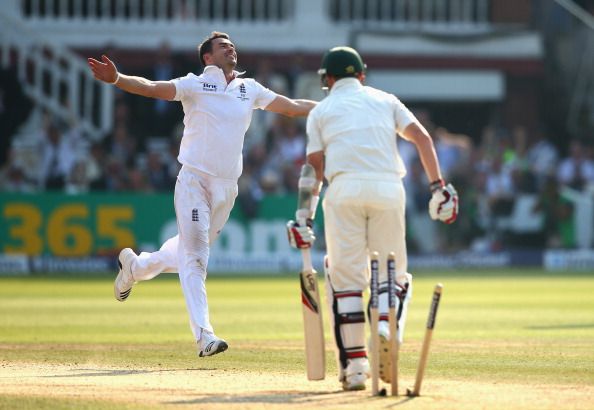
Bowlers: cricket’s ever-changing survivors

James Anderson of England has used his ability to swing the cherry the other way quite tactfully, in recent times. (Getty Images)
Sunil Gavaskar has always maintained that cricket is a batsman’s game. He argues that on a given day if a batsman scores a century and a bowler takes a five-for, then it would invariably be the willow holder who would dominate the next day’s newspaper headlines.
One may agree to disagree with the legendary opener’s viewpoint but there is little denying that over the years most of the major changes in rules have benefitted the batsmen; be it the introduction of covered pitch, the use of helmet, the shortening of boundaries or the imposed field restrictions in limited overs cricket.
Yet amidst all this, bowlers as a species have survived. And the cricketing universe can be thankful for that because it is the riveting battle between the bat and the ball that makes a game of cricket fascinating; in all three formats.
The key to their survival and indeed flourish in many cases has been their adaptability. Every time a rule has been tweaked in the ICC manual to favour the batsmen, bowlers have found a new way to pose different set of challenges to their batting counterparts. Listed below are some of the varied innovations that bowlers came up with to confront batsmen.
Reverse Swing:
The credit for introducing the world to the art of reverse swing goes to Imran Khan and his set of fast bowlers in the eighties, even though they were initially accused of illegal ball tampering for the same.
But over the years reverse swing was legitimised and considered as an ‘art’ of bowling. We all know how reverse swing can be produced by maintaining the shape and sheen of the ball on one side and letting the other side go through normal wear and tear.
What it did was to make fast bowlers relevant even in those dry surfaces, which were hitherto not considered conducive for them. It also doubled up the threat of the swing bowlers, who could trouble batsmen with conventional swing with the new ball and flummox them by reverse swinging the same cherry when it has lost its initial sheen.
What makes reverse swing more difficult to combat as compared to traditional in-swing for a right-handed batsman is the fact that the ball swings very late in the air, as a result of which it is very difficult for the batsman to gauge its exact line.
That is why according to veterans like Rahul Dravid, while facing reverse swing a batsman has to look to go forward (to combat the amount of swing) but at the same time he cannot commit himself too early as he is not sure of the exact amount of swing.
To complicate things further, expert exponents of reverse swing like Wasim Akram, Zaheer Khan and Freddie Flintoff frequently switched their bowling line form round the wicket to over the wicket without compromising on either their speed or accuracy.
At one point of time in late nineties and early noughties, non-strikers used to help the batsmen in strike to gauge which way the ball would reverse swing by indicating on which side of the bowler’s wrist is holding the shiny side of the ball. New Zealand deployed this strategy quite successfully against Javagal Srinath during their tour of India.
To counter that, bowlers these days hide the ball during their run up to the crease. Initially Zaheer Khan and now James Anderson have deployed this tactic quite successfully.
Slower deliveries:
As the limited overs component started increasing in the ICC cricket calendar, the usage of slower deliveries started gaining more prominence. In the shorter formats of the game, the 22 yards are normally designed to suit stroke play (true bounce, little lateral movement) and batsmen tend to hit through the line of the ball.
This is where foxing him with change of pace becomes critical. However it is not as easy as it sounds, for batsmen also look at the wrist of the bowler at the point of delivery to detect if he has tried any variation. There is a wide array of slower balls that bowlers have in their arsenal in modern day cricket.
First up, there is the back of the hand slower delivery. According to legends like Allan Donald, this is perhaps the most difficult variant of slower delivery to execute as there is maximum chance of ball slipping out of the hand. But if executed well, it is very difficult for batsmen to read it as it is delivered without significant bending of the wrist and also because the seam position of the ball remains identical to that of any normal length delivery.
The second variant, off-cutter, is perhaps the most widely used form of slower ball as it comparatively easier to control the same. In contrast the leg-cutter is not that popular among seam bowlers. Venkatesh Prasad used the leg-cutters to telling effect during his playing days.
The split finger slower ball was made popular by Dilhara Fernando. He had confessed that during a local tournament in the Emirates Island, the ball was slipping out of his hand because of the extreme sweat in his palms and fingers. Due credit has to be given to him for having spotted the opportunity that was presented through it and for having worked on it long enough to successfully execute it at international level.